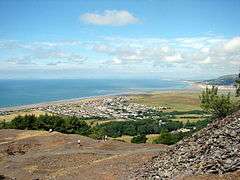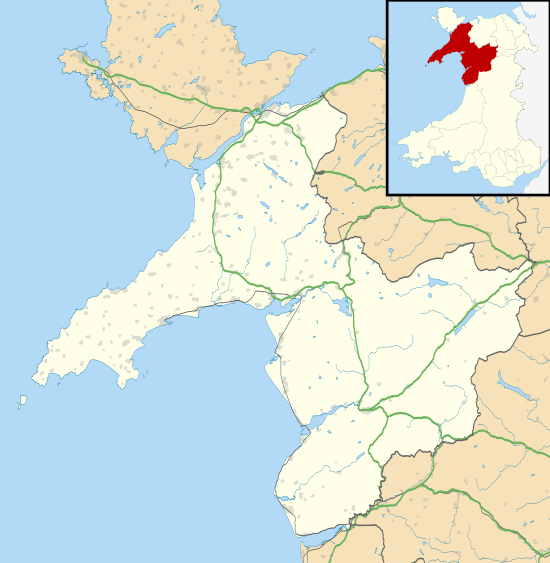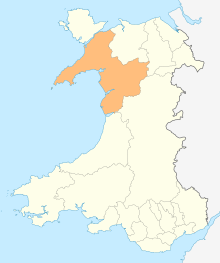Fairbourne
Fairbourne is a Welsh seaside village. It lies on the coast of Barmouth Bay in Arthog community, to the south of the estuary of the River Mawddach in Gwynedd, surrounded by the Snowdonia National Park. It is in an area listed by Gwynedd council for managed retreat due to rising sea levels.[1]
| Fairbourne | |
|---|---|
 Fairbourne viewed from Golwen slate quarry | |
 Fairbourne Location within Gwynedd | |
| Population | 1,031 |
| OS grid reference | SH614130 |
| Community | |
| Principal area | |
| Ceremonial county | |
| Country | Wales |
| Sovereign state | United Kingdom |
| Post town | FAIRBOURNE |
| Postcode district | LL38 |
| Dialling code | 01341 |
| Police | North Wales |
| Fire | North Wales |
| Ambulance | Welsh |
| UK Parliament | |
| Senedd Cymru – Welsh Parliament |
|
History
Fairbourne was part of the historic county of Meirionnydd. The area was originally salt marshes and slightly higher grazing lands. Before development began in the mid 19th Century there were three farms on the land.[2] The coastal area was originally known as Morfa Henddol, while the promontory outcrop now occupied by the Fairbourne Hotel was called Ynysfaig.
About 1865 Solomon Andrews, a Welsh entrepreneur, purchased the promontory. Over the next several years he built a seawall for tidal protection and several houses. To facilitate this he built a 2 ft (610 mm) gauge horse-drawn tramway from the main railway to the site in order to bring in building materials.[3] In 1916, the tramway was converted to a 15 in (381 mm) gauge steam railway.[4] Sir Arthur McDougall (of flour making fame) had been looking for a country estate, but when he discovered this area, he soon conceived of it as a seaside resort. In July 1895 Arthur McDougall purchased a substantial acreage from land speculators, which he enlarged by additional lots the following year. He hired a builder in 1896 who began the development of a model seaside resort.
Unusually for Gwynedd county, the village has no official Welsh-language name. Unlike most of Gwynedd, where Welsh is the majority language, English is the predominate language in Fairbourne with most of its inhabitants coming from or descended from those who came from England.[5]
Managed retreat
Fairbourne has been identified as unsustainable to defend, given predicted sea level rise.[6] The best estimate at present is that the area will be abandoned between 2052 and 2062, though the range of uncertainty is between 2042 and 2072. This is based on a rise in critical sea level of 0.5 metres (1.6 ft).[7] There is an intent to maintain defences of the village for a period of 40 years from 2014. The policy of managed retreat was strongly opposed by local residents.[8][9]
Attractions
Beach
The Blue Flag beach at Fairbourne is a two-mile stretch of beach, backed by steep pebble banks, which exposes a vast amount of golden sandy beaches from mid-tide level. At the northern end the beach joins the Mawddach Estuary, while at the southern end of the beach is squeezed between sheer cliffs and the sea. The beach is an attractive venture for people exercising their dogs, however, during the summer months there is a dog ban enforced on the central area. There is sufficient access to the beach for those visitors with prams and/or wheelchairs, making this a welcoming rural location for all. The beach is fronted by tank traps known as "Dragon's Teeth" dating from the Second World War.
Railway and Ferry
The Fairbourne Railway has provided a link from the village to Penrhyn Point for over a century. It runs regular passenger services between April and October.
The Barmouth Ferry sails from the seaward end of the Fairbourne Railway to Barmouth/Abermaw.
Transport
Fairbourne railway station is served by the Cambrian Coast Railway, which runs from Machynlleth to Pwllheli and is operated by Transport for Wales.
Lloyds Coaches also operate a regular bus service to Dolgellau and Tywyn.
References
- Thomas, Rhidian (11 February 2014). "Sea level threat to force retreat of communities in Wales". BBC News. Retrieved 11 February 2014.
- "Fairbourne, a potted history". Bill Hyde. 2013. Archived from the original on 10 August 2013.
- Reader's Digest Association (1979). The Past all around us: an illustrated guide to the ruins, relics, monuments, castles, cathedrals, historic buildings, and industrial landmarks of Britain. Reader's Digest Association. p. 150. OCLC 220770889.
- Billing, Joanna (2003). The Hidden Places of Wales. Aldermaston, Berkshire, England: Travel Publishing Ltd. p. 147. ISBN 978-1-904434-07-8.
- Wall, Tom (18 May 2019). "'This is a wake-up call': the villagers who could be Britain's first climate refugees". The Guardian. Archived from the original on 18 May 2019.
- Wall, Tom (18 May 2019). "'This is a wake-up call': the villagers who could be Britain's first climate refugees". The Guardian. ISSN 0261-3077. Retrieved 4 March 2020 – via www.theguardian.com.
- CNN, Story by Thomas Page; video by Phil Black, Ingrid Formanek, Luis Graham-Yool and Lewis Whyld. "Sea level rise could make climate refugees of UK village". CNN. Retrieved 4 March 2020.
- "Welsh village to sue government over 'alarmist' rising sea level claim". The Telegraph. 11 February 2016. Archived from the original on 11 February 2016.
- Harries, Robert (26 May 2019). "The Welsh village being abandoned to the sea because of climate change". Wales Onlline. Archived from the original on 26 May 2019.
- W.J.Milner Rails through the Sand. Rail Romances, Chester, 1996. ISBN 1-900622-00-9
External links
| Wikimedia Commons has media related to Fairbourne. |
| Wikivoyage has a travel guide for Fairbourne. |
